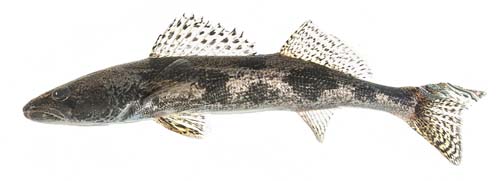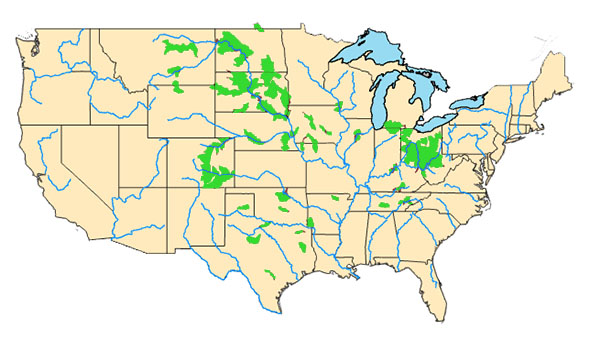Saugeye are a hybrid of a sauger and walleye. The are often found in regions of the midwest and southeastern United States where both of sauger and walleye are present. Saugeye make an excellent table fare and are sought after for their white, flaky meat, with a taste just a touch sweeter than that of walleye. Anglers use a variety of methods to catch saugeye including jigging, drift fishing, cast and retrieve, still fishing, trolling, and even fly fishing.

Habitat: Lake, Pond, River
How to Identify Saugeye
Saugeyes are a hybrid species created when male a sauger mates with a female walleye. Saugeye are often mistaken for either of their parent species. To tell the difference between a saugeye and walleye or sauger, you need to examine the markings and coloring on the fish.
Saugeye tend to be a bronze-silver to yellow-gold color. They have distinctive saddle-shaped markings and dark blotches that extend along their sides similar to those found on a sauger (although a bit less prominent). Saugeye have a lot of rough scales along their cheek. Walleye have smooth cheek scales and sauger only have a few rough cheek scales.
The best way to differentiate a saugeye from a walleye or sauger is to examine the dorsal fin. Similar to a walleye, saugeye have a dark blotch at the rear base of the dorsal fin. The dorsal fin on the saugeye is also covered with spots, though not as distinct as those found on the dorsal fin of a sauger.
Saugeye will typically have distinct streaks between dorsal spines and 1 to 2 rows of spots along the base of the fin. Walleye will only have indistinct streaks between dorsal spines and sauger will have more than two rows of spots. Saugeye also exhibit white tips on their tail and anal fins similar, but less defined, than those on a walleye.
An average saugeye measures between 12 and 18 inches and weighs between 1 and 2 pounds—although a few specimens have tipped the scales at over 14 pounds. Saugeye are larger than sauger, but noticeably smaller than walleye.
Indentifying characteristics of saugeye.
- Tanish to yellow-gold in color
- Distinct dark blotches along the sides
- Rough scales along the cheek
- Dark blotch at the rear base of the dorsal fin
- Dorsal fin is cover with indistinct spots
- Distinct streaks between dorsal spines
- 1-2 rows of spots along the base of the dorsal fin
- White tips on the lower part of the tail and anal fins
Where to Catch Saugeye
Saugeye are found from as far north as Montana and North Dakota southeast through the central U.S. down to Texas and east to West Virginia. They are concentrated in basins and tributaries associated with the Mississippi River. Saugeyes naturally coexist in areas where walleye (mom) and sauger (dad) are present.

Saugeyes naturally coexist in areas where walleye (mom) and sauger (dad) are present.
The following are habitats where you can catch Saugeye:
- Cliffs and Steep Shore Banks
- Dams and Falls
- Gradual Shores
- Lake and Pond Fishing Holes
- Inlets and Outlets
- Inside Turns and Coves
- Open Water
- Shoreline Shallows
- Sunken Objects
How to catch Saugeye
Many of the same methods and techniques for fishing walleye and sauger will also work for fishing saugeye. In fact, saugeye are often caught as bycatch when anglers are targeting walleye or sauger. Fishing a jig tipped with live bait is the most effective method for catching saugeye.
Saugeye can be caught using bait casting or light-spinning tackle with lures or live bait. Drift fishing, still fishing, trolling, and even fly fishing are also methods anglers use for fishing saugeye.
The best time to fish saugeye is at night. As twilight nears, saugeye come up from the deep to forage in the shallows. During this time it’s not uncommon to find saugeye in no more than four feet of water. As daylight breaks, saugeye move back to the depths and anglers will need to fish deeper water.
Look for saugeye in the clear waters of reservoirs, especially near drop-offs. However, they tend to fair better in murky water than walleye, and can be found a bit shallower when water is stained or cloudy. Saugeye will hold to good bottom structure including humps off points, stones, tree stumps, and even old road beds.
In the winter and spring, they saugeye often travel up rivers and gather just below dams in areas where there is slower current.
The following are productive fishing methods and techniques for catching saugeye:
Best Lures, Bait & Tackle to catch Saugeye
Saugeye will hit both bait and lures. For lures, try crankbaits, spinners, spoons, and jigs; and for bait, use minnows, nightcrawlers, and leeches. Like Walleye, saugeye love leeches. Again, a jig tipped with a minnow or worm is your best bet for catching saugeye.
The following are fishing lures, bait and tackle that can be used to catch Saugeye:



